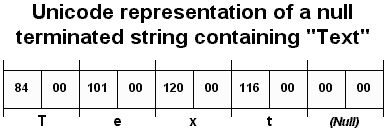
One of the most common storage formats is ASCII (American Standard Code for Information Interchange).ASCII is 7-bit, giving a total of 128 possible characters. In most cases, it is extended to 8-bit, giving a full 256. Older systems, and some current ones as well, use ASCII as the primary format for storing text. These include: DOS, Mac-OS, Windows 95 (not the NT/2000 series).
Unfortunately, given the rather small number of possible characters in ASCII, it is unable to represent any languages besides English and other western languages.
The solution to this dilemma is Unicode. In Unicode, each logical character is represented by a 32-bit integer, giving a total 65535 characters that can represented. This allows Unicode to represent all the ASCII codes, the characters of other languages, and leaves plenty of room for expansion.
For more information please see www.unicode.org
Unicode characters are technically 2-byte integers, making the order in which the bytes are stored important. These bytes are stored using Little Endian byte ordering, which means the lower byte of the 32-bit integer is stored first to the file.

The Unicode characters with the values 0-127 are equivalent to those in ASCII, making the conversion between Unicode and ASCII rather trivial. Note that the most significant byte (the second listed in Little Endian) will contain a 0 in every case.